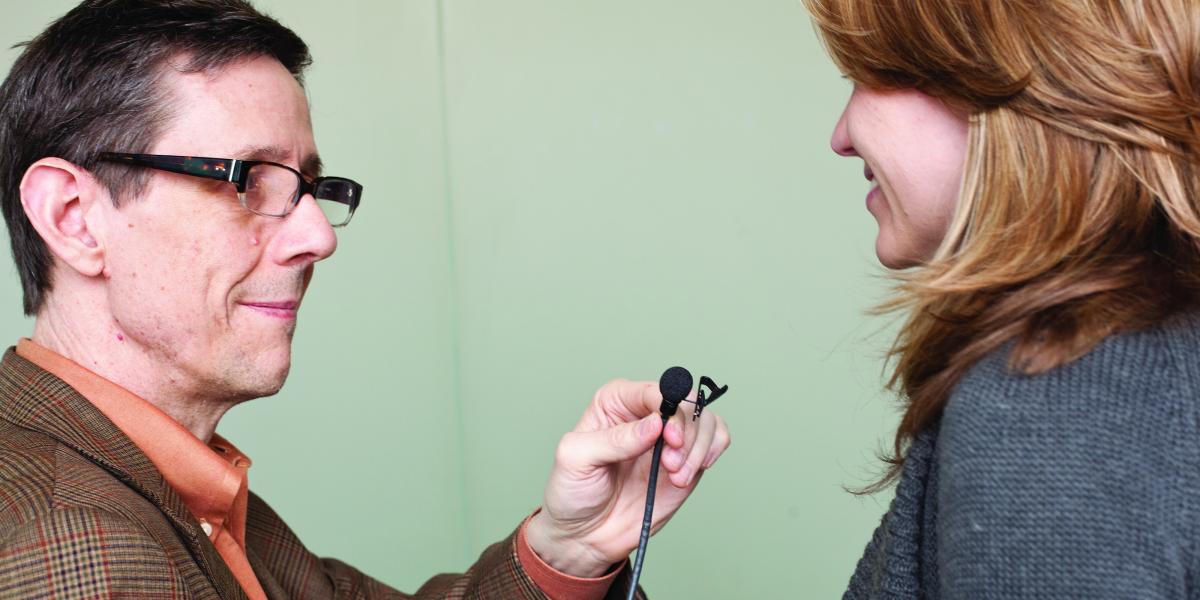Sensing Change
A behavioral scientist discovers the advantages of real-time data
Thomas Glass, PhD, knows precisely where to find the letter on his desk, crowded though it is with piles of paper.
“This letter is one of the most interesting things in my career,” says the associate professor in Epidemiology.
The correspondence is from a 59-year-old Baltimore woman, who wrote to Glass about her neighborhood in response to a 2008 newspaper story about his research; the article was headlined “Where You Live Can Harm Health.”
“It’s a battleground,” Glass reads from the letter. “Drug dealing and gun violence. We cannot sit on our porches or front steps for fear of robbery and drive-by shootings. You can’t even take a walk around the neighborhood on a beautiful sunny day or a lovely summer evening. When you have to leave for work before sunup and come home after sundown, you just say a prayer and go with God.”
“That’s why I study neighborhoods,” says Glass, who, for 10 years, has researched Baltimore neighborhoods to answer the question, How does where you live affect your health? Since 2001, as part of the Baltimore Memory Study (BMS), Glass and other researchers at the School have tracked 1,100 older Baltimore residents in 64 contiguous neighborhoods—from dangerous to middle class to affluent—studying the connections between neighborhood characteristics and residents’ health. They’ve published papers on how hazardous neighborhoods adversely affect cognition, cardiovascular health and obesity.
But Glass has long been troubled by the accuracy of traditional data-gathering methods in social behavior research—mainly interviews by researchers and surveys completed by study participants, known as pen and paper surveys. “We basically have used that method since the 1950s, even though we’ve learned in the meantime that human memory does not work like a tape recorder,” he says.
Five years ago, Glass got the opportunity to test another approach to data collection when he was awarded a National Institute on Aging grant to use wireless sensors in his Baltimore Memory Study research. Unable to find the technology he needed at a reasonable price, Glass and his colleagues designed their own system to measure social, physical and cognitive functioning.
Over the past five years, 100 participants in the BMS wore three sensors—a GPS, a voice recorder and an accelerometer, neatly bundled in a hip pack—for five days, as the devices collected real-time data on physical activity, geographical location and speech patterns.
The sensed information translates into “millions of data points,” Glass says, that when analyzed as a whole using specially designed computer algorithms, will allow researchers to create movies, rather than isolated snapshots of people’s lives. By studying the data, Glass will be able to answer questions such as, Did they stay home during the day or leave the house? Where did they go? Did they socialize or remain isolated?
Glass says that the project—the first of its kind to gather audio, motion and geographical data in real time—is an important step in building a case for using sensors more widely in research. “The idea of getting increased accuracy and validity by removing the human brain as the mediator between us and the information is, I think, going to be a revolution in behavioral science,” he says.
In the field of gerontology, for example, the mining of data patterns through computer analysis could potentially identify seniors at risk for cognitive decline at an earlier stage than is now possible.
“We currently have no way to treat Alzheimer’s disease, and we’re not really good at preventing it once symptoms start. Part of that is that tests only reflect changes when it’s too late,” Glass says. “If we can flag people in time, we can do things like lower blood pressure, prevent minor strokes and other things that might slow down cognitive decline.”
Michelle Carlson, PhD, associate director of the Center on Aging and Health, views sensor-captured data as a path to answering complex questions about functioning “from the standpoint of integrating the body and the brain.”
Says Carlson, an associate professor in Mental Health, “I think it’s the future of data collection in terms of helping us find targets for intervention.”
In Glass’s work on neighborhoods, he has a particular interest in the theory that living in a dangerous environment increases a person’s chances of becoming disabled as an older adult. He’s excited about being able to combine information on neighborhood safety—911 calls, violent crime numbers, vacant buildings and other statistics—with sensor data that measure social interactions and that can indicate stress through voice patterns.
“The idea is to provide stronger evidence that where you live matters for health, so that we have more reason to worry about it as a society and make different choices about how we allocate resources,” he says.
Glass has applied for grants to study stress in young drug addicts with sensed, real-time data. Ultimately, he hopes to establish a center for sensor-based research in public health to improve the measurement of complex human behaviors. “Everything we care about in public health—fundamental rock bottom—is about complex behaviors,” he says, “taking drugs, what we eat, physical activity, who we have sex with, who we love—and they’re all extremely difficult to measure the way we’ve been doing it.”
